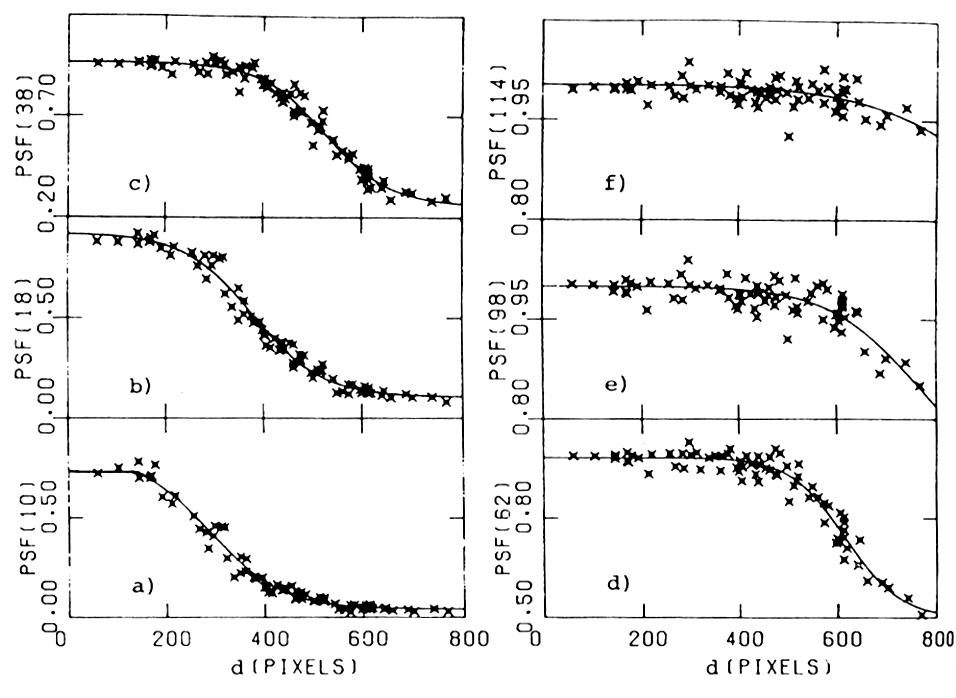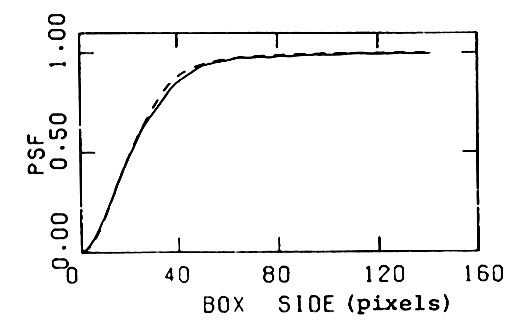THE LEIT OFF-AXIS POINT SPREAD FUNCTION AND THE LONG TERM DETECTION EFFICIENCY1. The Off-axis Point Spread Function.In a previous report (EXOSAT express No. 12, p.33) the factors that determine the limiting sensitivity of the EXOSAT channel multiplier array (CMA) were described. It was found that a decrease in sensitivity occurs at large off-axis angles because of the dependence the telescope point spread function (PSF) on distance from the detector centre. To properly estimate the count-rate of sources detected at large off-axis angles it is essential to have a good knowledge of the PSF at any location in the FOV. A preliminary study of the dependence of the PSF on source position was presented in the previous article using data from a 43 point raster scan of the X-ray source CYG X-2. In addition to this scan, we have now included 34 bright serendipitous point sources (selected from more than two thousand entries contained in the preliminary version of the EXOSAT LE Data Base) detected at various distances from the detector centre. In Figure 1 the positions of all 77 locations considered are plotted in detector coordinates.A cumulative point spread function, PSF(i), gives the fraction of source counts in a square box of side i (in units of 4 arcsec pixels) centered on the barycenter of the photon distribution. PSF(i) will approach unity for larger and larger values of i. In Figure 2a-2f, the measured values of PSF (i) for i ranging from 10 to 114, are shown for a range of distances, d, from the detector center (for the case of LE1 the image center is located at X=136,Y=61). The PSF does not change significantly within 180 pixels of the center (see previous article). At larger distances the following function was found to provide a good description of the data:
where d is in units of 4 arcsec pixels and A(i),B(i),C(i) and D(i) are parameters that depend on the chosen box size. The best fitting model to each case is shown as a solid line in Figures 2a-2f. The best fitting values for 14 different box sizes are given in Table 1. The expected value of the PSF(i) at any given off-axis angle greater than 180 pixels can be calculated using eq (1) and the best fitting parameters listed in Table 1, by interpolating between the given values of i. An example of a PSF constructed with this procedure for the case of an off-axis distance of 27 arcminutes (400 pixels) using 10 values of i and interpolating with a weighted parabola method is shown in Figure 3 as a dashed line. For comparison the measured PSF from a bright pointlike source detected at the same off-axis angle is shown as a solid line. The two curves are almost indistinguishable. The PSFs obtained with this method, and using at feast 10 different values of i, accurately reproduce all the PSFs derived from the sources utilized in our analysis.
II.The LE efficiency as a function of time.Here we examine the stability of the CMA filters and telescope as a function of time by comparing the count rates measured during seven observations of the Crab Nebula that were performed roughly at evenly spaced time intervals during the mission. Figure 4 shows the percentage deviations from the average count rate, , defined as , defined as
plotted as a function of observation date for the five most frequently used filters. We conclude the following: (i) the LE sensitivity did not change more than ~1% during the mission. (ii) There are systematic errors, of the order of 2-3%, which must be taken into account when estimating source count rates. These are caused by uncertainties in the relative quantum efficiency across the detector FOV and by the process of rescaling the (nonuniform) background to the position of the source. This is only valid in the central ~15 arcmin radius part of the detector. The analysis of a raster scan of the Crab Nebula indicates that at large off-axis angles the systematic errors increase to 8-10%.
P. Giommi
Figure 1The position of all 77 sources used for the study of the evolution of the LE PSF with off-axis angle in detector coordinates.
Figure 2 a) - f)The fraction of source photons contained in a square box of side 10 (a), 18 (b), 38 (c), 62 (d), 98 (e) and 118 (f) pixels is plotted against the distance between source position and detector centre.
Figure 3Comparison between a PSF constructed using the method described in the text and a PSF actually measured from a bright source detected at an off-axis angle of 27 arcmin (400 pixels).
Figure 4The percentage deviations from the mean count rate of the Crab Nebula are plotted against observation date for five different filters.
| |||||||||||||||||||||||||||||||||||||||||||||||||||||||||||||||||||||||||||||||||







